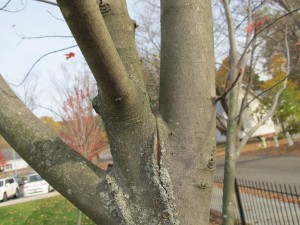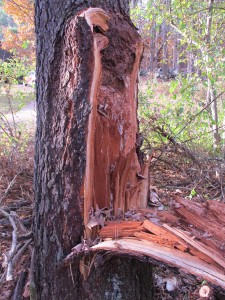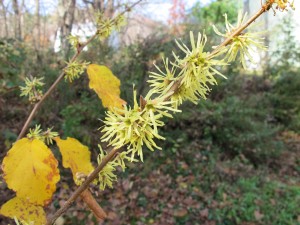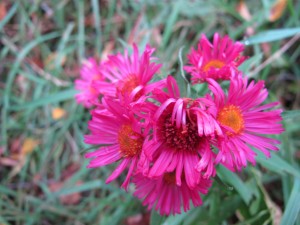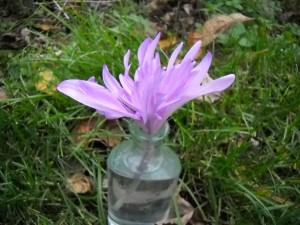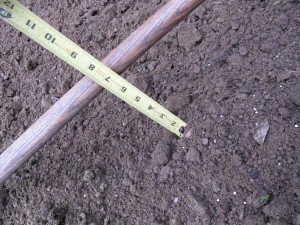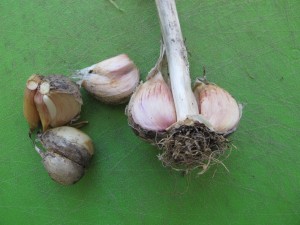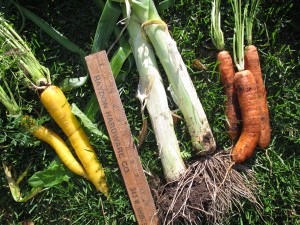Pruning Maples, Birches and More
Now, as the leaves are disappearing (or accumulating on the lawn, demanding in a whiney voice to be raked up and used for mulch) I am pruning hardwoods like maples, birches and other deciduous trees and shrubs. For me, happiness on a sunny fall day is improving the looks and long-term health of trees by pruning – so I’m out doing some now most nice days.
It’s easier to see the form and structure of trees and shrubs at this time of year because the leaves are mostly gone. I know that some gardeners prefer to prune in the spring – I do fruit trees then – but not all trees can be pruned then. Maples and birches, among others, bleed lots of sap if pruned in March. So I do them now.
Before pruning a young tree, take some time to look at mature trees in your neighborhood. The best ones have open arms: their branches are well spaced and have branches angling off at a 45 degree angle from the trunk. Often these are trees that grow along a fence line or a dirt road so that they had sunshine coming from all sides as they grew.
You may also see some trees that have several fat trunks or stems growing almost parallel, reaching for the sky. These are the trees that split and break off in wind or ice storms. Why? An arborist might use the words “included bark.” This refers to bark that gets engulfed by the growth of 2 trunks that grow too close together. As the trunks grow fatter, bark between them is swallowed up by the two competing trunks, and creates a weak spot that can more easily split.
Recently I saw a large native cherry tree that had split in half. It was, according to my count of the rings, 65-75 years old and it was more than 50 feet tall. Sadly, it had twin trunks and one half split off and fell during a wind storm. I could see that fungus had weakened the wood – the seam between the two trunks was not a tight seal, allowing water and the fungus to enter. And now the remaining trunk is open to the elements and will not survive as long as it might otherwise.
If you have a young tree that has branches or trunks that are growing together and have a tight angle between them, you should act. You will need to remove one of the competing stems. This may seem drastic, and is best done before the stems are more than 2 or 3 inches in diameter. I removed a few recently while working at the Kilton Library in West Lebanon, NH.
Of course, removing a 2-inch stem also means you will lose all the side branches that are growing on it, too. Before unsheathing my big pruning saw I walked around each tree for several minutes. I looked at the two competing stems and tried to mentally erase one from the picture I was looking at. Would there be a big gap in the canopy? Would there be small branches that could fill in after surgery? Yes, there are always small branches that will fill in.
There are also “dormant buds” on trees that can produce branches if the tree “senses” a gap in the canopy. Trees, obviously, don’t have brains that tell them when to send out new branches. But there are stimuli such as sunshine coming through an empty spot in the canopy that will “tell” the tree to set out new growth.
At Kilton Library (where all the trees were planted in 2010) I studied the trees that I had pruned last year. I had removed some two-inch diameter stems that were growing together too tightly. I was pleased to see that the trees looked full. No big gaps. In general, removing a big stems or branch does not seem so drastic after it’s gone – even though it seems scary when it’s time to cut. And removing a big branch helps the tree to be more open, thus allowing every leaf to get some direct sunshine, which is good.
At the back of the property there is a maple that “wanted” to send branches over the fence and reach out for sunshine on the neighbor’s property. I noticed that one branch I had removed last year – only an inch in diameter or so – had sent a new branch back over the fence. Amazingly, it had grown 5 feet in one year! Interestingly, the leaves on it were nearly twice the size of the leaves on the rest of the tree. So trees will keep on producing branches to take advantage of sunshine, no matter what we do.
So if you haven’t taken a good look at the arrangement of trunks and larger branches on your trees, this is a good time to do so. You might be able to prune them yourself, but you might have to call an arborist who can take out a large branch or trunk if need be. It would be money well spent – 50 years from now you just might lose a tree, or half a tree, if you don’t do so.
Henry Homeyer is the author of 4 gardening book, and a children’s chapter book, a fantasy-adventure about a boy and a cougar. His web sites are www.gardening-guy.com and www.henryhomeyer.com.
What’s Blooming Now in the Garden
By mid to late October, many gardens are looking quite drab. That need not be the case, and this week I’d like to mention a few of the flowering plants that are cheering up my gardens now.
Witch hazel (Hamamelis virginiana) is a native shrub that grows in the understory and blooms now (or in the early spring, for Hamamelis x intermedia). The flowers are not dramatic on most varieties– they are less than in inch in diameter, and are arranged close to the stem. Although I’ve seen witch hazel in a public garden that had red blossoms, the native species that I grow is a pure yellow and the petals are very frilly – you could say “spider-like”. The look best after leaf drop.
As a kid I went to a barber who used a witch hazel tonic as an astringent after shaving men. To make us kids feel more grown up, perhaps, he applied some on the back of our necks when he was done with us. It is a very fresh scent that is made from the bark of young stems and roots of the shrub. The leaves, when crushed, also have a nice smell.
My Seven-Sons Flower Tree (Heptacodium miconioides) is still blooming now. This is a smallish tree (under 30 feet tall), but one that grows extraordinarily fast. It is not unusual for new stems to grow 3 to 5 feet in a season. I love the bark, which is exfoliating (shaggy). Its flowers are small and white, and appear in panicles (clustsers).
I am experimenting with mine to see how it does as a pollarded tree. Pollarding is a process of cutting off most new branches back to major branches every few years, keeping the size in check and crating large knobs where new growth originates. It’s a very popular pruning technique in Europe. Last year I cut off all the smaller branches, leaving a trunk and three major branches. This year I got dense clusters of branches growing from the ends of those major branches. Interestingly enough, many of the new stems are growing out and down, almost like a weeping tree.
Chrysanthemums great fall flowers that I buy in pots each year around Labor Day. I treat mums as annuals, even though some varieties will overwinter. Why? Because to get a dense, compact plant, one must pinch back the growing stems two or more times during the summer, and I have too much going on to remember to do so most years. There are people who do this for a living, and I am happy to let them do it. I like mums in window boxes (the smaller ones) and the big, dramatic ones in pots on my front steps. When they come in peat or cardboard pots I transplant them into plastic pots as the former dry out too quickly.
Fall asters have been splendid this year, both those that I planted and those growing along the roadside or edges of fields. The wild ones are mostly blues and purples. I purchased a pink aster that is in bloom right now, a variety called ‘Alma Plotschke’. She is an intense, deep rose pink and not nearly as tall as the wild ones.
Some smaller wild asters(12 to 24 inches tall are blooming at the edge of my lawn. My reference text on native flowers (The Illustrated Book of Wildflowers and Shrubs by William Carey Grimm) lists 29 species of wild asters. These short ones have bluish-white blossoms. I believe mine are the common blue wood aster (Aster cordifolius), which is usually a light blue or lavender. The differences between wild asters can be minute and there is much variety within a species, so they could be the white wood aster (Aster divaricatus), which is also common in New England. It doesn’t matter, they’re all lovely.
Fall crocus are wonderful! True fall crocus (Crocus sativus) are not fully hardy in my cold Zone 4 garden. Various vendors list them as hardy to Zone 4 or 5 or 6. I have had them winter over, and have a client nearby who has had them blooming each fall for years – in a Zone 4 garden. These crocus are the source of saffron, but I’ve read that it takes 10,000 flowers to make an ounce of saffron!
Colchicums are also called fall crocus, but are not true crocus. They look like crocus on steroids – they are commonly 6 inches tall! I planted a lot 10 years ago, but each year I have a few less. Unfortunately their stems do not usually support the flowers, so they flop. To avoid this I have planted them in amongst a ground cover like myrtle (Vinca minor) that helps to hold them up. Mine are mainly pink, but also have a few white, both as singles and doubles.
Some annual flowers hold up against frost for awhile, too. My favorite right now is Brazilian verbena (Verbena bonariensis), which is hardy down into the 20’. It grows three feet tall on thin, stiff stems with little clusters of purple-blue flowers. The flowers seem to float above shorter things. Look for it next summer.
Fall flowers are a gift. Even when I’m thinking about woodpiles and snow shovels, a few hardy plants keep on bringing me joy.
Henry is the author of 4 gardening books and a children’s book about a boy and a cougar. His Web sites are www.Gardening-guy.com and www.henryhomeyer.com.
Planting Shrubs
Irish writer Thomas Moore (1779-1852) once wrote, “A piece of the sky and a chunk of the earth is lodged in the heart of every human being.” I would like to add “And hopes for a seed waiting to be planted”. It’s why we garden – or I do, anyway – planting, watering, tending and harvesting make me feel alive, keep my temperament balanced and give me joy.
It’s mid-October and there aren’t any seeds to be planted just now (unless you count garlic cloves as seeds). But this is a good time to plant trees and shrubs. Plants store energy from photosynthesis all summer in their roots, and then in the fall the roots use that energy to extend their range – even after leaf drop. Roots grow, apparently, until the ground freezes. Roots start growing again in the spring, and do much of their root growth in early summer.
For me, the hardest part of planting a tree or shrub is finding the proper place to plant it. I have a couple of acres, but I’ve been planting things here for over 40 years and I’m running out of space. Not only that, each tree or shrub has specific needs for sunlight exposure, moisture and soil type.
Soil is the easiest to “customize”. I can change the pH and texture or tilth pretty easily. But my back field is pretty wet, and many woody plants don’t like their roots sitting in soggy soil. With a high water table, I have to limit what I plant there. (Willows love it, and my magnolia , too.)
Sunlight is also hard to adjust. Yes, I have a chain saw, but nice trees keep on getting nicer as they grow – but creating more shade. Many nice flowering plants like full sun, which is defined as 6 hours or more of summer sun per day.
After removing a pear tree earlier this year, I had space to plant a blue hydrangea (A ‘Twist and Shout’ variety of the Endless Summer series) that had been growing in a big pot near my front door all summer. I cleared out the weeds and loosened the soil in a 5-foot circle. Then I modified the soil to meet the needs of this particular shrub: I added peat moss and garden sulfur to acidify the soil, stirring it in with my CobraHead weeder.
It’s important to get the depth of the planting hole right for trees and shrubs, much more so than for vegetables or flowers. Trees (and to a lesser degree, shrubs) can be damaged if planted too deeply, as the bark on the trunk is very susceptible to fungal rot if covered with soil or mulch. Vegetables such as tomatoes and broccoli can be planted a little deep in order to stimulate new root growth along the buried stem.
It is good to dig the hole for a tree or shrub just the depth of the root ball. After I removed my hydrangea from the pot I measured the root ball and found it to be 8 inches from surface to bottom. I dug a hole and measured the depth of it by placing the handle of a rake across the hole, and then checking it with a measuring tape. It was 6 inches at first, so I carefully scraped out 2 more inches. That allowed me to set the root ball on unexcavated soil; soil that has been dug out and replaced tends to settle – which you don’t want to happen. Sometimes, if the soil is really awful, I will dig down deeper, and then add improved soil and pack it down afterwards with my foot.
The shape of a planting hole for a tree or shrub is important. It should be flat on the bottom, and gently slope upwards toward the surface of the soil. It should be wide, not deep. A minimum width should be three times the size of your rootball, and five times is even better. Roots of most trees and shrubs go wide, not deep. Roots go out beyond the ”drip line” – the area directly under their leaves. So it is good to have nice loose soil around your tree or shrub to facilitate root growth.
Winter is not so far away. In order to allow roots to grow and develop for as long as possible, it is good to place a two-inch layer of mulch over the root zone – but no more than 2 inches. The mulch will keep the soil warm later into the fall and keep lawn mowers and those string trimmers at bay.
I’ve seen trees with what I call “mulch volcanoes” – mulch piled up deeply against the trunk of a tree. That can be a death sentence, as most bark mulch or ground branches will retain moisture and microbes that will eventually rot the cambium layer of a tree. It takes years to kill a tree with bark mulch, so many people don’t attribute the layer of mulch to the death of their tree six to ten years later. Leave a “donut hole” free of mulch around your tree to avoid that.
So go to your local garden center and buy yourself a nice tree or shrub. There is still plenty of time to plant. And I think you’ll feel a great sense of accomplishment if you do.
Henry Homeyer is a gardening teacher, coach and public speaker. Reach him at henry.homeyer@comcast.net or P.O. Box 364, Cornish Flat, NH 03746. He is happy to answer gardening questions, but please include a stamped envelope if sending a real letter.
Garlic and Carrots and Leeks, Oh My!
Some vegetables are as reliable as a sturdy shovel. Others – we all know – please us some years, disappoint us others. We grow tomatoes never knowing if the harvest will be bountiful or meager. But garlic and carrots and leeks, for me at least, are totally reliable. Year after year I know that I’ll harvest a good crop.
Now is the time to plant garlic. If you haven’t bought any garlic for planting, you’d better hustle to get some before your local farm stand closes for the season. It is, after all, officially fall. Avoid buying grocery store garlic as it is often treated with a chemical to keep it from sprouting – and is probably the wrong kind. But your local farm stand or farmers market should have garlic that will work just fine. Some garden centers will have seed garlic for sale, too.
A few words about types of garlic: there are two basic categories and many different varieties, each with a distinct flavor and “bite”. What we grow in New England is hard-neck garlic, which has a stiff woody stalk around which the individual cloves (sections) grow. Soft-neck garlic is generally from California, and is the kind that is braided and hung on restaurant walls – or found in grocery stores. Soft neck garlic is less hardy and may not overwinter.
I plant my garlic in mid-October. This allows the plants to establish roots, and then go dormant. If you plant in spring, you may find the garlic bolts and does not grow big cloves.
If you are using your own garlic that you harvested in August, pick your finest heads (or bulbs) to use for planting. In my experience, small heads will produce small heads next year. And for cooking, big heads are easier to work with.
Prepare a bed by digging in compost to enrich the soil and to provide good drainage. I create raised beds that are 30 inches wide and 6 inches above the walkways. I rake the bed smooth and create furrows 6 to 8 inches apart across the row. I then sprinkle organic fertilizer in the furrows and scratch it in. Next I separate the cloves and plant them about 4 inches apart and 2 inches deep. I cover the cloves and pat down the soil.
Finally I cover everything with a thick layer of straw or mulch hay. I spread the hay 8 to 12 inches deep (and fluffy), but by spring it has packed down and is more like 4 or 5 inches of cover. This mulch keeps most weeds at bay, but the garlic grows right through it.
Most of my carrots are still in the ground – they tolerate frost and cold, and get sweeter after a good chilling – some of the starches turn to sugars. I generally store carrots for winter in a spare fridge in the basement, but you can also store them in a bucket of damp sand in the garage, mudroom or bulkhead. Mice love carrots, so I recommend covering the bucket of carrots with quarter-inch wire mesh.
Another way to store carrots is to leave them in the ground. You can keep the ground from freezing by covering them with a thick layer of mulch hay that is then covered with a layer of leaves. I put a pole at each end of the row so that I can find it under a deep January snow. This method works fine, though I have suffered some rodent damage on occasion. If you find any chewed carrots now, harvest and store inside.
Leeks are another friend of mine that always produce well. I love leek and potato soup in the winter so I store most of mine, though I keep some for fresh use as a substitute for onion when my onions (fickle, some years) are less than bountiful. In my experience, leeks stored in the fridge or cold cellar lose their appeal quite quickly, so I freeze them. I clean and chop them up, then freeze in freezer-grade zipper bags. I do not blanch them.
Here is my version of leek and potato soup:
3 strips lean thick-cut bacon
2-3 cups chopped leeks
2 -3 cups diced potatoes
½ cup flour
2 chopped tomatoes
2 cups milk
1 handful chopped fresh parsley
1 bay leaf
¼ teaspoon nutmeg
½ teaspoon cinnamon
1 teaspoon Herbes de Provence
Lightly brown bacon in a heavy soup pot, then add leeks and potatoes, stirring constantly to brown. Add 4-6 cups water. In a dish stir water into the flour to get a thick but lump-free mixture. Add to soup pot and stir well. Add spices and tomatoes and simmer for half an hour. Just before serving add milk but do not boil the milk. You can make this vegetarian by avoiding the bacon and substituting butter or olive oil.
I have a vegetable garden, in part, because I love to cook. Eating my own vegetables give me great pleasure, particularly in winter – which is just around the corner.
Contact Henry by email at henry.homeyer@comcast.net or write him at PO box 364, Cornish Flat, NH 03746. Visit his Web site at www.Gardening-Guy.com.



